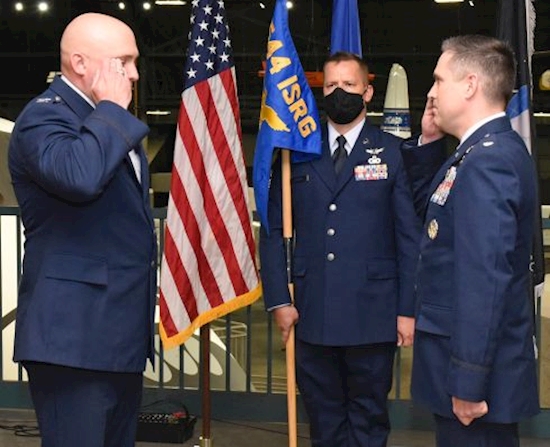Air Force intelligence squadron deactivates, then activates as part of Space Force
DAYTON, Ohio (Tribune News Service) — The Air Force’s 18th Intelligence Squadron was deactivated then activated as the 73rd Intelligence, Surveillance and Reconnaissance Squadron, U.S. Space Force, during a ceremony held Sept. 3 in the National Museum of the U.S. Air Force’s Space Gallery.
The 73 ISRS is one of the first ISR squadrons to support space operations and acquisition. It will be located within the National Air and Space Intelligence Center, Wright-Patterson Air Force Base, as the 18 IS was. It is assigned to Space Force Delta 7, Peterson-Schriever Garrison, Colorado.
“What an auspicious day for the Space Force,” said Col. Chandler Atwood, commander, Space ISR Delta (Delta 7), U.S. Space Force, who presided over the in-person and remote ceremony. “Thank you for supporting a truly historic event in American military history.”
He told the 73 ISRS members present that they will build upon the legacy of the 18th Intelligence Squadron’s ethos of space dominance.
“As a newly formed ISR Delta, we build on your squadron’s legacy of success and the great capabilities of the 73 ISR Squadron that bring to bear against our enemies in the space warfighting domain,” Atwood said.
“Our Space Force Delta 7 will be the focal point to provide timely, accurate and war-winning intelligence to combatant commands,” he continued. “As we build the Space Force Delta 7, we’ll break conventions and we will boldly move forward with new organizational structures, processes and technology. Much like the Air Force in 1947, you – the space warfighters of the 73 – will not only be a part of history, you are making it and will most definitely leave your fingerprints as plank holders of the U.S. Space Force. Remember, we are always above.”
After the 18th Intelligence Squadron’s guidon was furled and the squadron deactivated, Lt. Col. Nathaniel Peace assumed command of the 73 ISRS.
“While our mission set has changed from an air-centric focus to a space-centric focus, since 1993 the 18 IS has developed a reputation as a premier U.S. Air Force ISR squadron, ever vigilant in supporting the space community through multiple military campaigns and conflicts, always adhering to our motto, ‘Space Dominance,’” he said.
“It was no surprise to us, with those familiar with our history, that the Airmen and the capabilities of the 18 IS were selected for transition into the U.S. Space Force,” Peace continued.
The 73 ISRS has three assigned detachments on three continents, including Fort Meade, Maryland; RAF Feltwell, United Kingdom; and Osan AB, South Korea, he said. It is also the most mature squadron within Delta 7 and the largest ISR squadron in the Space Force.
“Let it be known, we do not shrink from our responsibilities – we embrace them, and we welcome them,” Peace said.
He ended his remarks by tongue-in-cheek paraphrasing the coda to the Star Trek television show: “Space, the final frontier. These are the voyages of the 73 ISR Squadron. Its mission: to provide advanced developmental and operational intelligence to the U.S. Space Command. To seek out new adversarial capabilities and technologies. To boldly go where no ISR squadron has gone before.”
Following the ceremony, Peace said the 73 ISRS embraces the Wright-Patt community. He thanked NASIC and its commander Col. Maurizio Calabrese, and Wright-Patt’s 88th Air Base Wing for their partnership and support.
“We will continue to go out and hit home runs and grand slams in the defense of our nation going forward,” Peace said.
Master Sgt. Michelle Lowery, 73 ISRS, Det. 6 superintendent, Fort Meade, Maryland, attended the ceremony. She had been part of the 18 IS at Wright-Patt from 2010 to 2014.
“Being one of the first superintendents at a Space Force detachment is awesome; it’s amazing, it’s exciting, and I am really looking forward to the future and all the opportunities the Space Force is going to present and bring,” she said.
Capt. Richard Yetter, acting detachment commander, Det. 6, also was in attendance and is assisting with the transition of his unit to the 73 ISRS.
“I have a little bit of a background working in space and I’m just ecstatic to be back actually working in space all over again – especially under this new command,” he said.
1st Lt. Kendrick Fischer, 73 ISR Operations Flight commander, helped coordinate the ceremony.
“I think this is a historical moment. Just to be part of this is really eye-opening. I’m proud of this and I look forward to the future of the Space Force,” Fischer said.
©2020 the Dayton Daily News (Dayton, Ohio)
Visit the Dayton Daily News (Dayton, Ohio) at www.daytondailynews.com
Distributed by Tribune Content Agency, LLC.
Source: www.stripes.com

